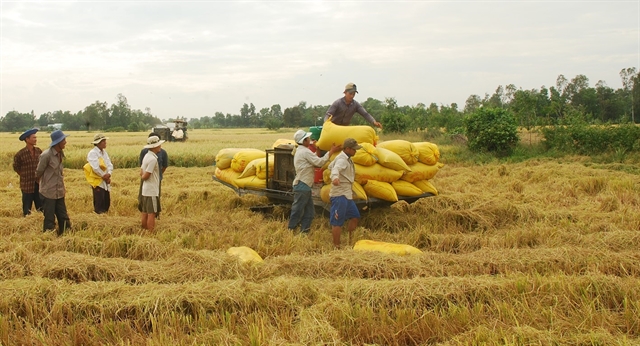 Society
Society

The Cửu Long (Mekong) Delta province of Bạc Liêu has 26 large-scale rice fields with a combined area of 50,000ha, according to its Department of Agriculture and Rural Development.

|
| Harvesting rice in Bạc Liêu Province. – VNA/VNS Photo Huỳnh Sử |
BẠC LIÊU The Cửu Long (Mekong) Delta province of Bạc Liêu has 26 large-scale rice fields with a combined area of 50,000ha, according to its Department of Agriculture and Rural Development.
In the first half of this year alone five fields with an average size of 100ha were created.
More than 30 individuals, co-operatives, co-operative groups, and companies have joined hands with farmers to carry out the province’s large-scale rice fields and guarantee outlets for them.
The programme, which began in 2012, is yielding positive results like increasing farmers’ incomes and providing them with guaranteed outlets for their crops.
It has also increased farmers’ awareness of economy of scale.
A large-scale rice field is created by pooling individual farmers’ fields to increase productivity and reduce costs.
Farmers benefit by sowing seeds at the same time to prevent disease outbreaks, using machines and harvesting at the same time.
The province’s large- scale fields produce two to three rice crops per year.
In Hòa Bình District, there are six of these fields with a combined area of nearly 16,000ha.
Dương Văn Thới, chairman of the Hòa Bình People’s Committee, said rice production under the model reduces costs by VNĐ2-3 million ($85 -130) per ha per crop.
Besides, companies guarantee purchase of the harvest at VNĐ1,500 per kilogramme higher than the market price, he said.
Nguyễn Văn Thích, who has a 3ha rice field that is part of a large-scale rice field in Hồng Dân District’s Ninh Quới A Commune, said he had derived a lot of benefit by joining.
Farmers’ incomes from the large-scale rice fields are VNĐ10-15 million ($430-645) higher per hectare.
His family’s income is now steady and better than before joining.
The department has instructed localities to zone and implement the model.
It has encouraged farmers to use high-quality rice varieties to meet the market demand and grow specialty strains like một bụi đỏ Hồng Dân and tài nguyên Vĩnh Lợi.
The province uses techniques like the “3 reductions and 3 increases”, “one must and five reductions” and integrated pest management in rice cultivation.
The “3 reductions and 3 increases” refers to a reduction in the use of seeds, fertilisers and plant protection chemicals to achieve increases in productivity, quality and efficiency.
In its agricultural restructuring plan for 2016-20, the province seeks to expand the area under large-scale rice fields to 100,000ha by next year, or 51 per cent of the province’s entire rice farming area.
To achieve the target, it would expand advocacy in localities with good conditions for developing the model, Lưu Hoàng Ly, the director of the department, said.
The province would actively call on companies and co-operatives to invest in the model to guarantee outlets for farmers, he added.
Trịnh Văn Cường, director of the Vĩnh Cường Co-operative, said the province should have better policies to ensure companies co-operate with co-operatives and the latter could get access to soft loans.
The province should support investment in agricultural infrastructure, he said.
Rice is the province’s main crop. VNS